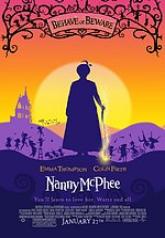
"Knight Thoughts" -- exclusive web content
Merchant-Ivory for kids:
Nanny McPhee
1-27-06 "Knight Thoughts" web exclusive
by Richard Knight, Jr.
Nanny McPhee
1-27-06 "Knight Thoughts" web exclusive
by Richard Knight, Jr.


Emma Thompson creates a franchise for herself with the delightful Nanny McPhee
If Merchant-Ivory had ever produced one of their civilized pictures for kids, it might have looked something like Nanny McPhee which
has the tag line, "you'll learn to love her warts and all" and based on the evidence, this is a good example of truth in advertising.
As essayed by Emma Thompson (who also wrote the screenplay), the hideously ugly nursemaid who gets prettier with each magical
thump of her cane, is a subtle delight. This wonderful picture, tasteful, ribald, and just the right length, is a jolly good show.
There have not been many magical nannies on the screen -- and all, of course, pale in the shadow of Mary Poppins. With Julie
Andrews in the title role, the character became an instant sensation and continues to resonate 40 years later. Sadly, even with all
those subsequent Poppins books waiting for a sequel, Andrews never played the role again. Hopefully the same won't be said for
Emma Thompson. I hope this is the first in a long series of outings with Nanny.
The story, based on a series of books ("Nurse Matilda," "Nurse Matilda Goes to Town," etc.) first published in the 1960s and long out
of print, is a familiar one: widowed father with unruly brood (there are seven in all) has come to his wits end until Nanny McPhee
magically shows up on his doorstep and in a matter of moments has begun to whip the children into shape. Before she arrives, we
are given a good look at the eccentric Brown household, headed by Colin Firth as their distracted father, the kids (a distinctive lot for
once) and the overwhelmed staff of maid, Evangeline (the sweet Kelly Macdonald) and cook, Mrs. Blatherwick (a dryly funny Imelda
Staunton). The charming house the Browns live in is a riot of different colors -- there are bright blue, green, and yellow walled rooms
(it looks like the family lives inside a candy store) and lots of rose and blood red accents. I have not seem this intense use of color
for the sake of color itself since Moulin Rouge, Dick Tracy and Suspiria. Credit production designer Peter Howells for the film's witty look
-- topped by an eye-popping wedding scene at the 11th hour. The house is situated in one of those breathtakingly perfect English
countrysides just down the lane from a quaint village and it appears that we are in the Edwardian period (or close to it).
Mr. Brown works as a not very successful undertaker (and there's a hint that his two middle-aged, fastidious helpers are gay) and
unknown to the rascally kids, must marry soon or have the family's allowance from the villainous Aunt Adelaide (Angela Lansbury,
funny in a cartoon character inspired performance) cut off. Into this chaos comes the mysterious, black clad McPhee who, has "five
lessons to teach." As the kids and adults learn the five lessons, Nanny magically becomes prettier, too.
Thompson, who is a glorious and welcome presence in any movie she inhabits, once again is an actor that can say with the crook of
an eyebrow what lesser mortals would take paragraphs to convey. Just listen to her repeated use of Nanny McPhee's skeptical "eh"
(or is it an abbreviation of "oh yes"?) and the variations that she brings each time she utters it. She is supported by an expert cast
of English actors both young and old. The film is a sort of Mary Poppins/Sound of Music Redux but has charm to spare on its own. It's
not quite as miraculous as Babe but it's working the same territory. And for kids, parents, and kids at heart, that's a nice -- and
increasingly rare -- place to visit.
has the tag line, "you'll learn to love her warts and all" and based on the evidence, this is a good example of truth in advertising.
As essayed by Emma Thompson (who also wrote the screenplay), the hideously ugly nursemaid who gets prettier with each magical
thump of her cane, is a subtle delight. This wonderful picture, tasteful, ribald, and just the right length, is a jolly good show.
There have not been many magical nannies on the screen -- and all, of course, pale in the shadow of Mary Poppins. With Julie
Andrews in the title role, the character became an instant sensation and continues to resonate 40 years later. Sadly, even with all
those subsequent Poppins books waiting for a sequel, Andrews never played the role again. Hopefully the same won't be said for
Emma Thompson. I hope this is the first in a long series of outings with Nanny.
The story, based on a series of books ("Nurse Matilda," "Nurse Matilda Goes to Town," etc.) first published in the 1960s and long out
of print, is a familiar one: widowed father with unruly brood (there are seven in all) has come to his wits end until Nanny McPhee
magically shows up on his doorstep and in a matter of moments has begun to whip the children into shape. Before she arrives, we
are given a good look at the eccentric Brown household, headed by Colin Firth as their distracted father, the kids (a distinctive lot for
once) and the overwhelmed staff of maid, Evangeline (the sweet Kelly Macdonald) and cook, Mrs. Blatherwick (a dryly funny Imelda
Staunton). The charming house the Browns live in is a riot of different colors -- there are bright blue, green, and yellow walled rooms
(it looks like the family lives inside a candy store) and lots of rose and blood red accents. I have not seem this intense use of color
for the sake of color itself since Moulin Rouge, Dick Tracy and Suspiria. Credit production designer Peter Howells for the film's witty look
-- topped by an eye-popping wedding scene at the 11th hour. The house is situated in one of those breathtakingly perfect English
countrysides just down the lane from a quaint village and it appears that we are in the Edwardian period (or close to it).
Mr. Brown works as a not very successful undertaker (and there's a hint that his two middle-aged, fastidious helpers are gay) and
unknown to the rascally kids, must marry soon or have the family's allowance from the villainous Aunt Adelaide (Angela Lansbury,
funny in a cartoon character inspired performance) cut off. Into this chaos comes the mysterious, black clad McPhee who, has "five
lessons to teach." As the kids and adults learn the five lessons, Nanny magically becomes prettier, too.
Thompson, who is a glorious and welcome presence in any movie she inhabits, once again is an actor that can say with the crook of
an eyebrow what lesser mortals would take paragraphs to convey. Just listen to her repeated use of Nanny McPhee's skeptical "eh"
(or is it an abbreviation of "oh yes"?) and the variations that she brings each time she utters it. She is supported by an expert cast
of English actors both young and old. The film is a sort of Mary Poppins/Sound of Music Redux but has charm to spare on its own. It's
not quite as miraculous as Babe but it's working the same territory. And for kids, parents, and kids at heart, that's a nice -- and
increasingly rare -- place to visit.
